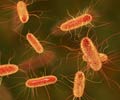The first complete map of the Germany E. coli O104 genome has been released by the BGI

The draft shows that the disease strain has a circular chromosome 5,278 kbp in length, and three additional plasmids 88 kbp, 75 kbpand 1.5 kbp in size, respectively.
The chromosome contains around 5,000 predicted coding sequences (CDSs), covering 87.09pc of the genome.
The biggest plasmid is highly homologous to a previously sequenced plasmid isolated from a horse and carrying additional multi-drug resistance genes.
The smallest one is a so-called 'selfish plasmid' carrying only two genes, one of which encodes a DNA replication protein, the other carrying the aggregative adherence fimbria I (AAF/I) gene cluster, which is associated with E. coliaggregation ability and virulence, and likely to play a role in the persistence of the disease.
The study confirms that the outbreak strain belonged to an EAEC (enteroaggregative E. coli) lineage, but acquired the Shiga toxin producing ability by the integration of a phage genome.
Advertisement
The researchers concluded that the deadly 'Germany E. coli' is not a completely new bacterium and can be considered a 'hybrid' strain, now temporarily termed Shiga toxin-producing enteroaggregative Escherichia coli (STpEAEC).









